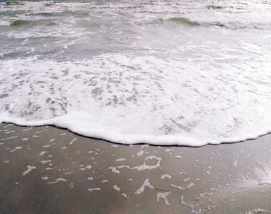Danish-Polish Environmental Co-operation 1991-2000
Chapter 6
Future perspectives
Environmental co-operation around the baltic sea
Danish support to Central- and Eastern Europe will continue in the future. The new DANCEE strategy 2001-2006 is to a great extent reflected in the existing Country Programmes, which are made in close co-operation with the individual countries. Also in the future priority will be given to the improvement of air- and water quality, to better treatment and reduction of the amounts of waste, and to protection of the nature. All this will increasingly be seen in the perspective of a future membership of the European Union, which is the overall objective for the applicant countries where DANCEE operates.
During the most recent years an increasing number of the DANCEE consulting projects have been implemented in relation to the EU approximation process, which includes the transition and the implementation of EU environmental directives.
Because a majority of the countries in Centraland Eastern Europe co-operating with Denmark focusing on future EU accession, it is only natural that the planing of future institutional projects and investment projects will concentrate as much as possible on fulfilling the EU environmental directives.
This means that there is a general tendency in the co-operation to focus increasingly on the Polish EU accession process, which is also reflected and integrated in the projects. Today, all projects have to conform to the requirements of both Polish environmental legislation as well as EU environmental directives.
A new strategy sees the daylight
The implementation of the new Danish strategy for environmental support to Eastern Europe is a revision of the existing country programmes made in close co-operation with the individual countries. It is expected that the country programmes are to cover a 3-year period in order to remain dynamic and be able to follow the country's development closely.
The new strategy include the following main objectives
- to strengthen and specify the overall framework of the activities of DANCEE,
- to form the basis for an update and revision of the country programmes for the individual countries
- to specify the objectives of the activities within the different priority areas
The strategy covering the period 2001 - 2006 is based on the Danish Government's strategy for support to Eastern Europe: "Regeringens Overordnede Strategi for Øststøtten - med særlig hensyn til Østersøen" from 1997 - the so-called Baltic Sea Initiative in force from 1998 - 2001. This initiative comprises the Danish support to Poland, Estonia, Latvia, Lithuania and Russia.
The strategy is also based on the Parliament decision of May 5, 1999 in which focus is put on the Baltic Sea Region, support to the approximation of the EU-applicants and increased support in SNG-countries and to the Balkan reconstruction.
Priority to cross-sectoral activities
The updated country programme will seek to focus the support on fewer priority areas and on certain geographic areas such as selected regions in the beneficiary country. When preparing the country programmes Danish support will be co-ordinated with other multiand bilateral donors with a view to obtaining a higher degree of synergy.
The number of priority areas have increased compared to the 1993 strategy as chemicals and multi-disciplinary items have also been included. This reflects the increasing differentiation of the need for support as well as of the degree of development between the beneficiary countries.
Future priority areas will comprise air and water quality, treatment of waste, chemicals and biodiversity. At the same time, crosssectoral activities will be given higher priority. This will be done to strengthen local institutions and professional expertise within the countries, promote public participation in decisionmaking within the environmental field, ensure that the private sector in the countries assume "environmental responsibility" and to assure that the countries fulfil international conventions within the environment.
The Baltic Agenda 21
The sector-integrated environmental cooperation is part of the action plan for the Baltic Agenda 21, which was adopted by the Baltic Sea countries in 1998. The objectives of this Agenda was to strengthen the environmentally sustainable development based on market economy principles in Estonia, Latvia, Lithuania, Poland and the Russian regions of St. Petersburg and Kaliningrad.

The Baltic Agenda 21 is based on the global Agenda 21, which was adopted by the United Nations' members in 1992 in Rio. An additional main objective of the Baltic Agenda was to support the preparation for EU membership.
Protection of the Baltic Sea
Also the Polish-Danish environmental cooperation shall be seen in a wider international perspective. Poland and Denmark have a common interest in protecting the Baltic Sea the world's largest brackish water system. This co-operation is carried out between the Baltic Sea countries under the so-called Helsinki Convention, HELCOM.
A considerable part of the efforts to protect the Baltic Sea concerns the reduction of the waste water pollution from urban areas. As a result of the Polish-Danish bilateral cooperation a number of projects have been carried out which support the objectives of the Helsinki Convention. The protection of the environment in the Baltic Sea Region will also be an important issue in the future bilateral cooperation.
The regional activities in the Baltic Sea Region to limit oil pollution are still given high priority in the implementation of the MARPOL and the HELCOM conventions. Similar regional activities will also be relevant in the Black Sea region.

Other major regional activities are under preparation within the Dioxin and Persistent Organic Pollutants' (POP) fields in order to strengthen the future phase out of the POPs and reduction of the dioxin emissions. Furthermore, the phasing out of other hazardous chemicals will also be implemented.
The regional activities are characterised by the fact that there is a regional perspective for such a co-operation across the national boundaries environmentally, politically and because the countries have a common interest in e.g. the Baltic Sea catchment area.
The nature projects are other examples of cross-border projects, for which the sustainable solutions require an extensive cooperation across country borders.